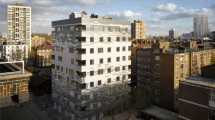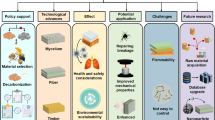Abstract
The objective of this study is to investigate how the specific heat capacity (cp) value of a material changes with respect to temperature and heating rate of that material. In-depth knowledge in the variation of cp will provide a better knowledge of the thermo-physical properties of these materials and will increase the capabilities and fidelity of computational fluid dynamics (CFD)-based fire modelling. The models and simulations are reliant on input data gained through experimentation and this allows for the present study to provide such input data and trends, which are useful in understanding how fires respond in different situations. The value of cp in relation to the rate of temperature change has been measured using differential scanning calorimetry (DSC) and hot disk analysis (HDA). This study encapsulates the determination of cp values, trends and equations for poly(methyl methacrylate), pinewood, pinewood char, and two fabrics: cotton and wool. The cp values were found to increase with the sample temperature and for the two fabrics; they vary with the change in heating rate. The derived equations show that cp values from DSC and HDA are comparable. To include these relationships in CFD-based fire models, a set of suggestions have been made.








Similar content being viewed by others
Abbreviations
- β s :
-
Heating rate (K min−1)
- C :
-
Specific heat (J g−1 K−1)
- c p :
-
Specific heat capacity (J g−1 K−1)
- c p,a :
-
Apparent Specific heat capacity (J g−1 K−1)
- c r :
-
Specific heat capacity of reference sample (J g−1 K−1)
- \(\frac{{\text{d}H}}{{\text{d}t}}\) :
-
Heat flow to the sample (mW)
- \(\frac{{\text{d}H_{\rm r} }}{{\text{d}t}}\) :
-
Heat flow to the reference material (mW)
- H :
-
Enthalpy (J)
- m :
-
Mass (g)
- m o :
-
Sample mass (g)
- m r :
-
Reference mass (g)
- p :
-
Pressure constant
- Q :
-
Heat flow (J)
- ΔQ :
-
Change in heat flow (mW)
- T :
-
Temperature (°C or K)
- ΔT :
-
Change in temperature (°C or K)
References
Drysdale D. An introduction to fire dynamics. Hoboken: John Wiley & Sons; 2011.
McGrattan K, McDermott R, Weinschenk C, Overholt K, Hostikka S, Floyd J. Fire dynamics simulator (Sixth Edition) user’s guide. Gaithersburg: National Institute of Standards and Technology; 2015.
Abu-Bakar AS, Moinuddin KAM, editors. Effects of variation in heating rate, sample mass and nitrogen flow on chemical kinetics for pyrolysis. In: 18th Australasian fluid mechanics conference Launceston, Australia; 2012; Launceston, TAS.
Kousksou T, Jamil A, El Omari K, Zeraouli Y, Le Guer Y. Effect of heating rate and sample geometry on the apparent specific heat capacity: DSC applications. Thermochim Acta. 2011;519(1–2):59–64. https://doi.org/10.1016/j.tca.2011.02.033.
Abu-Bakar AS. Characterization of Fire Properties for Coupled Pyrolysis and Combustion Simulation and Their Optimised Use [PhD]. College of Engineering and Science: Victoria University; 2015.
Linteris GT, Gewuerz L, McGrattan KB, Forney GP. Modeling solid sample burning with FDS. Nat Inst Stand Technol NISTIR. 2004;7178:36.
Czichos H, Saito T, Smith LE. Springer handbook of materials measurement methods. Berlin: Springer Science + Business Media; 2007.
Mettler-Toledo. Heat capacity determination at high temperatures by TGA/DSC Part 1: DSC standard procedures. Schwerzenbach, Switzerland; 2010.
Goodrich TW. Thermophysical properties and microstructural changes of composite materials at elevated temperature. Blacksburg: Virginia Tech; 2009.
Kodur VKR, Harmathy TZ. Properties of building materials. In: DiNenno PJ, Drysdale D, Beyler CL, Walton WD, Custer RLP, Hall Jr JR, et al., editors. SFPE handbook of fire protection engineering. 3rd ed. Quincy: National Fire Protection Association; 2002. p. 155–81.
Hohne GWH, Hemminger WF, Flammersheim HJ. Differential scanning calorimetry. Berlin: Springer-Verlag; 2003.
Abu-Bakar AS, Cran M, Moinuddin KAM. Experimental investigation of effects of variation in heating rate, temperature and heat flux on fire properties of a non-charring polymer. J Thermal Anal Calorim. 2019;137(2):447–59. https://doi.org/10.1007/s10973-018-7941-0.
Abu-Bakar AS, Cran M, Wadhwani R, Moinuddin KAM. Characterisation of pyrolysis and combustion parameters of charring materials most frequently found in buildings. J Thermal Anal Calorim. 2019. https://doi.org/10.1007/s10973-019-08688-6.
Thermtest I, inventor Thermtest Inc, assignee. Hot Disk Thermal Constants Analyser Instruction Manual. Canada; 2012.
Mettler T, inventor DSC1 User’s Manual. Switzerland; 2011.
Mettler-Toledo. DSC calibration, temperature and heat flow. Mettler-Toledo, Switzerland. 2018. https://www.mt.com/au/en/home/supportive_content/matchar_apps/MatChar_HB805.html. Accessed 14 Oct 2018.
Shaw T, Carrol J. Application of baseline correction techniques to the “ratio method” of DSC specific heat determination. Int J Thermophys. 1998;19(6):1671–80. https://doi.org/10.1007/BF03344918.
Milosavljevic I, Oja V, Suuberg EM. Thermal effects in cellulose pyrolysis: relationship to char formation processes. Ind Eng Chem Res. 1996;35(3):653–62. https://doi.org/10.1021/ie950438l.
Shalaev EY, Steponkus PL. Correction of the sample weight in hermetically sealed DSC pans. Thermochim Acta. 2000;345(2):141–3. https://doi.org/10.1016/S0040-6031(99)00357-3.
Rath J, Wolffinger MG, Steiner G, Krammer G, Barontini FC, Cozzani V. Heat of wood pyrolysis. Fuel. 2003;82(1):81–91. https://doi.org/10.1016/S0016-2361(02)00138-2.
Rudtsch S. Uncertainty of heat capacity measurements with differential scanning calorimeters. Thermochim Acta. 2002;382(1–2):17–25. https://doi.org/10.1016/S0040-6031(01)00730-4.
Strezov V, Patterson M, Zymla V, Fisher K, Evans TJ, Nelson PF. Fundamental aspects of biomass carbonisation. J Anal Appl Pyrol. 2007;79(1–2):91–100. https://doi.org/10.1016/j.jaap.2006.10.014.
Dieck RH. Measurement uncertainty: methods and applications. ISA; 2007.
Höhne G, Hemminger WF, Flammersheim H-J. Differential scanning calorimetry. Berlin: Springer Science & Business Media; 2013.
Gaur U, Sf Lau, Wunderlich BB, Wunderlich B. Heat capacity and other thermodynamic properties of linear macromolecules VI. Acrylic polymers. J Phys Chem Ref Data. 1982;11(4):1065–89. https://doi.org/10.1063/1.555671.
Soldera A, Metatla N, Beaudoin A, Said S, Grohens Y. Heat capacities of both PMMA stereomers: comparison between atomistic simulation and experimental data. Polymer. 2010;51(9):2106–11. https://doi.org/10.1016/j.polymer.2010.03.003.
Assael MJ, Botsios S, Gialou K, Metaxa IN. Thermal conductivity of polymethyl methacrylate (PMMA) and borosilicate crown glass BK7. Int J Thermophys. 2005;26(5):1595–605. https://doi.org/10.1007/s10765-005-8106-5.
Jansson R. Measurement of thermal properties at elevated temperatures—Brandforsk Project 328-031. SP Rep. 2004;2004:46.
Gupta M, Yang J, Roy C. Specific heat and thermal conductivity of softwood bark and softwood char particles☆. Fuel. 2003;82(8):919–27. https://doi.org/10.1016/S0016-2361(02)00398-8.
Harada T, Hata T, Ishihara S. Thermal constants of wood during the heating process measured with the laser flash method. J Wood Sci. 1998;44(6):425–31. https://doi.org/10.1007/BF00833405.
Gronli MG, Antal J, Varhegyi G. A round-robin study of cellulose pyrolysis kinetics by thermogravimetry. Ind Eng Chem Res. 1999;38(6):2238–44. https://doi.org/10.1021/ie980601n.
Koch P. Specific heat of ovendry spruce pine wood and bark. Wood Sci. 1968;1(4):203–14.
Koufopanos C, Lucchesi A, Maschio G. Kinetic modelling of the pyrolysis of biomass and biomass components. Can J Chem Eng. 1989;67(1):75–84. https://doi.org/10.1002/cjce.5450670111.
Ayeni N, Adeniyi A, Abdullahi N, Bernard E, Ogunleye A. Thermogravimetric and kinetic study of methylolmelamine phosphate treated–cotton fabric. Bayero J Pure Appl Sci. 2012;5(2):51–5. https://doi.org/10.4314/bajopas.v5i2.9.
Meilert K, Laub D, Kiwi J. Photocatalytic self-cleaning of modified cotton textiles by TiO2 clusters attached by chemical spacers. J Mol Catal A: Chem. 2005;237(1–2):101–8. https://doi.org/10.1016/j.molcata.2005.03.040.
Harris VM. Handbook of textile fibers. Washington: Harris Research Laboratories; 1954.
Horrocks AR, Price D. Fire retardent materials. Abington: Woodhead Publishing Limited; 2001.
Bras ML, Camino G, Bourbigot S, Delobel R. Fire retardancy of polymers: the use of intumescence. Cambridge: R Soc Chem; 1998.
Tuzcu T. Hygro-thermal properties of sheep wool insulation. Delft: Delft University of Technology; 2007.
Funding
This study was conducted through internal funding from Victoria University.
Author information
Authors and Affiliations
Corresponding author
Ethics declarations
Conflict of interest
The authors report no conflict of interest in this study.
Additional information
Publisher's Note
Springer Nature remains neutral with regard to jurisdictional claims in published maps and institutional affiliations.
Electronic supplementary material
Below is the link to the electronic supplementary material.
Rights and permissions
About this article
Cite this article
Pooley, L.I., Abu-Bakar, A.S., Cran, M.J. et al. Measurements of specific heat capacity of common building materials at elevated temperatures: a comparison of DSC and HDA. J Therm Anal Calorim 141, 1279–1289 (2020). https://doi.org/10.1007/s10973-019-09124-5
Received:
Accepted:
Published:
Issue Date:
DOI: https://doi.org/10.1007/s10973-019-09124-5




